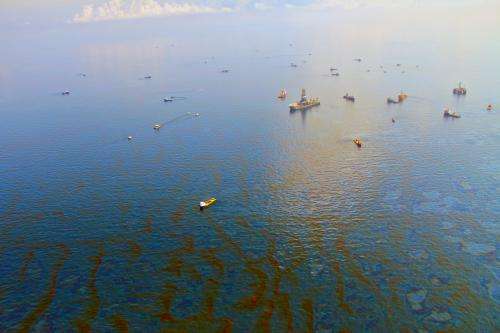Dr Pejcic says the research was prompted by incidents such as oil spills. Credit: GreenFireProductions
Within a decade, it may be possible to detect toxic petrochemical levels in the world's oceans on a daily basis, via a network of remote sensors.
Scientists at CSIRO and UWA have been working to develop a tool to detect aromatic hydrocarbons (benzene, toluene, ethylbenzene, p-xyleneand naphthalene) at very low concentrations in aqueous solutions.
CSIRO research scientist Bobby Pejcic says the research was prompted by incidents such as oil spills.
As aromatic hydrocarbons enter the seas from a variety of sources, it is important to be able to distinguish their origins.
"There is a great deal of concern regarding the impact of oils and petroleum-based hydrocarbons on the environment," Dr Pejcic says.
He gave the example of the Horizon oil spill in the Gulf of Mexico, whose environmental impact is still being investigated.
He says a science objective is to develop reliable chemical sensors to distinguish between different hydrocarbons in a complex system.
"Basically you have two components in the chemical sensor," Dr Pejcic says.
"One of them is a polymer-based membrane material and that's there to interact chemically with the hydrocarbon compound of interest.
"The other part is the transducer that converts the interaction process into a signal that can be measured and observed."
They have been investigating the use of a quartz crystal microbalance (QCM) transducer.
"You have this quartz crystal that oscillates or resonates at a certain frequency," Dr Pejcic says.
"When you deposit a mass on it, the crystal causes a frequency shift which is recorded by a frequency counter.
"The methodology involves putting a thin polymer film onto the surface of a quartz crystal and exposing the sensor to environmental samples.
"We modify the properties of the polymer by using a plasticiser molecule, and this allows certain hydrocarbons to interact more preferentially with the membrane compared to others.
"One of the research objectives is to understand why some plasticiser molecules perform better than others."
The plasticiser molecule and the polymer are joined by a weak chemical bond.
"It's a partitioning process," he says.
"When you add the plasticiser to the polymer you modify the free bonding properties of the polymer."
"By controlling the amount of the plasticiser on the polymer membrane, you can kind of tune the membrane's response to make it respond preferentially to certain hydrocarbon molecules compared to others."
He says the next step is to test the sensors with actual seawater samples.
Provided by Science Network WA























